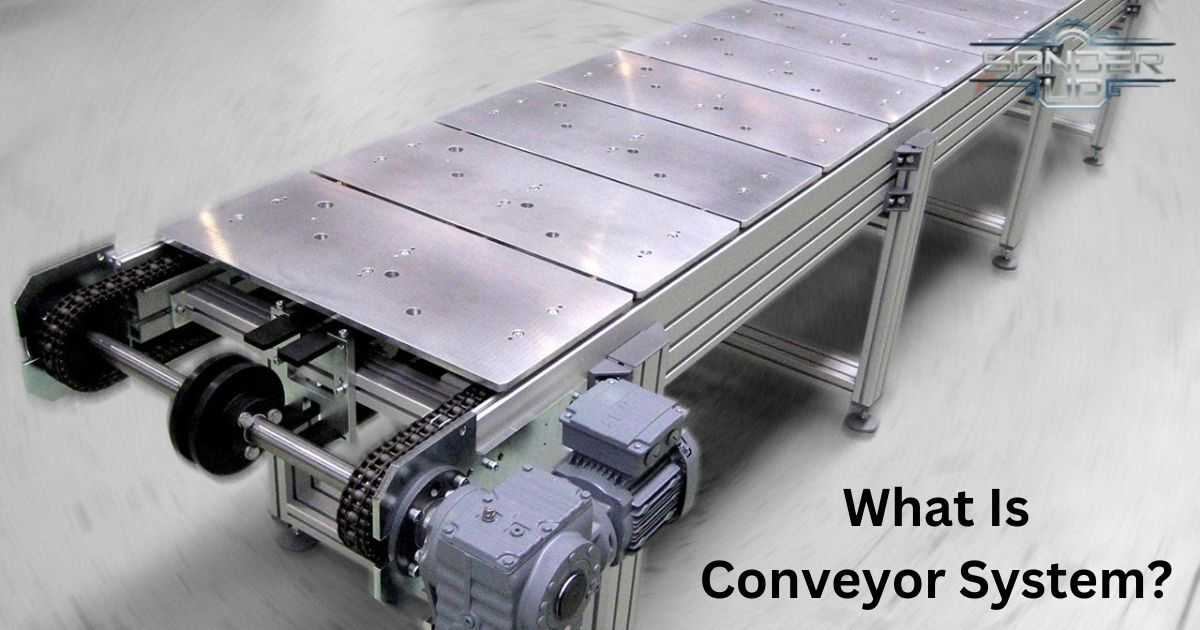A conveyor system is a mechanical device designed to move materials from one location to another within a facility. It’s often used in factories, warehouses, and airports to transport goods efficiently. The system consists of belts, rollers, or chains that transport items from one point to another. Motors power the movement, making the process smooth and continuous.
Conveyor systems help reduce manual labor, as they can move heavy or bulky items with ease. They also improve safety by minimizing the need for workers to lift and carry objects.
The design can be customized to fit specific needs, such as moving items up or down, around corners, or over long distances.
Conveyor systems can also sort, pack, or inspect items as they travel along the line. This automation increases efficiency, speeds up production, and helps businesses save time and money. They are essential tools in modern industrial operations.
What is conveyor system design?
Conveyor system design is the process of planning and creating a conveyor system that efficiently moves materials or products from one place to another within a facility.
This involves selecting the right type of conveyor (like belt, roller, or chain), determining the layout, and choosing components like motors, belts, and controls. The design also considers factors like the size and weight of the items being moved, the speed and capacity needed, and the available space.
Good conveyor system design ensures the system operates smoothly, meets the specific needs of the business, and integrates well with other equipment.
How do conveyor systems Work?
Conveyor systems work by using a combination of moving parts to transport materials from one place to another.
The parts of a conveyor system consist of the conveyor belt, rollers, pulleys, motors, drive belts, bearings, frames, and control systems. Here is a detailed explanation of how they work:
Motor
The motor is the driving force of the conveyor system. It converts electrical energy into mechanical energy, which powers the conveyor belt, chain, or rollers.
Depending on the system’s design and the load it needs to carry, motors can vary in size and power. Some systems use a single motor, while more complex systems might use multiple motors for different sections.
Belt or Chain
The belt or chain serves as the conveyor surface that carries materials from one point to another. The belt is typically made of durable materials like rubber, fabric, or metal, designed to handle various types of loads, from lightweight goods to heavy materials.
In some systems, a chain is used instead of a belt, particularly when dealing with heavier or bulkier items. The belt or chain runs in a continuous loop, driven by the motor, allowing for the constant movement of materials.
Rollers and Pulleys
Rollers and pulleys are crucial components that support and guide the belt or chain as it moves. Rollers are cylindrical tubes that the belt rests on, reducing friction and helping the belt move smoothly. These rollers can be positioned at regular intervals along the conveyor system.
Pulleys, on the other hand, are typically located at the ends of the conveyor system. They guide the belt or chain and help maintain tension, ensuring that the belt doesn’t slip or sag as it carries materials.
Frame
The frame is the structural support that holds the system together. It can be straight, curved, or inclined to fit the specific layout and purpose of the conveyor.
Sensors and Controls
Sensors detect items on the conveyor and send signals to control systems that adjust speed, direction, or sorting. This automation enhances efficiency and helps manage the flow of materials.
Working Mechanism
When the system is activated, the motor turns, moving the belt or chain and carrying materials along the path. The system can be configured to move items horizontally, vertically, or at an angle, depending on the needs of the operation.
Advanced Features
Some systems include automated sorting, speed control, and load balancing for improved performance. These features make conveyor systems highly efficient, reducing the need for manual labor and increasing productivity.
Safety Mechanisms
Conveyor systems include safety features like emergency stop buttons, guards, and alarms to protect workers and ensure safe operation.
Benefits of using a conveyor system
Using a conveyor system offers several advantages:
| Benefit | What It Means |
| Boosts Efficiency | Speeds up processes and reduces the need for manual work, making your operations run smoother. |
| Cuts Costs | Lowers expenses by reducing labor and minimizing workplace injuries. |
| Keeps Things Consistent | Ensures materials move steadily, so your workflow stays reliable and productive. |
| Improves Safety | Less manual handling means fewer injuries, creating a safer work environment. |
| Can Be Used Anywhere | Can be customized to handle different materials, making it useful in various industries. |
| Easy to Expand | Can be easily adjusted or expanded as your production needs grow. |
| Reduces Waste | Optimizes handling to minimize waste and product damage, leading to more efficient operations. |
Types of conveyor systems
Conveyor systems play a vital role in moving materials efficiently across various industries. Here is a comprehensive overview of different types:
1. Belt Conveyors
Belt conveyors are among the most common types, featuring a continuous belt that moves items from one point to another. The belt runs over pulleys, which allows products to glide smoothly along the conveyor.
They are ideal for transporting items over long distances in manufacturing, warehousing, and distribution centers. They can handle a wide range of products, from small packages to large boxes.
2. Gravity Roller Conveyors
Gravity roller conveyors use the force of gravity to move items along a series of rollers. This type of conveyor is simple and cost-effective, requiring no power source.
Items roll over the rollers, making it easy to transport goods in warehouses or sorting facilities. They are best suited for lightweight and medium-weight products and are often used for manual handling processes.
3. Chain Conveyors
Chain conveyors utilize a chain mechanism to move items, making them ideal for handling heavy and bulky materials. The chain moves along a track, carrying large or dense products that other conveyor types might struggle with.
They are durable and reliable, often found in automotive manufacturing and mining industries, where robustness is essential.
4. Motorized Roller Conveyors
Motorized roller conveyors feature powered rollers that move items along a track. Each roller has its own motor, providing controlled and adjustable movement.
This type of conveyor is efficient and can handle various load sizes, making it suitable for assembly lines and distribution centers where precise movement is necessary.
5. Slat Conveyors
Slat conveyors use slats, which are rigid plates attached to a chain or belt, to transport items. This design allows them to handle heavy, bulky, or irregularly shaped products. They are commonly used in industries like automotive manufacturing, where durability and the ability to handle large items are crucial.
6. Overhead Trolley Systems
Overhead trolley systems transport items via trolleys mounted on an overhead track. This setup frees up floor space and allows for efficient material handling in production lines.
They are commonly used in assembly lines and manufacturing facilities where vertical space can be utilized to improve workflow.
7. Monorail Conveyors
Monorail conveyors operate on a single rail and use trolleys or carriers to move items along this rail. This type of conveyor is ideal for fixed-path transportation and is often used in automotive assembly lines and other production environments where items need to follow a specific route.
8. Power and Free Conveyors
Power and free conveyors combine powered and non-powered sections, allowing items to move independently or be controlled as needed. This system provides flexibility and is used in complex manufacturing setups where items need to be moved in various ways or held at specific points.
9. Inverted Conveyors
Inverted conveyors have their belts positioned below the items being transported, allowing for processes or assembly work to be done on the top side. They are useful for handling items that require processing from the bottom and are often used in applications where the top surface needs to remain clear.
10. Paternoster Conveyors
Paternoster conveyors are vertical conveyors that move items in a continuous loop between different levels. They are useful for transporting small, lightweight items efficiently in retail and warehouse environments where vertical space is utilized.
11. Chute Conveyors
Chute conveyors use gravity to move items down an inclined chute. This simple design is effective for sorting or directing items to different locations. They are often used in packaging lines and distribution centers where items need to be moved quickly and efficiently without additional power sources.
12. Screw Conveyors
Screw conveyors consist of a rotating screw inside a tube or trough that moves bulk materials. The rotating screw pushes the material along the conveyor, making it ideal for handling powders, grains, and other bulk products. They are commonly used in agriculture, construction, and industrial processes.
13. Pneumatic Conveyors
Pneumatic conveyors use air pressure or vacuum to move materials through pipes. They are suitable for transporting powders, granules, and small parts. These conveyors are often found in industries like food processing and pharmaceuticals, where materials need to be moved without physical contact.
14. Vibratory Conveyors
Vibratory conveyors move items along a trough or channel using vibrations. The vibrations cause the materials to move in the desired direction. They are ideal for handling loose or granular materials and are commonly used in recycling plants and food processing industries.
15. Flexible Conveyors
Flexible conveyors are adjustable and can be configured into various shapes and lengths. They are portable and can be expanded or contracted as needed. Often used in loading and unloading operations, they provide versatility in handling different types of products and adapting to changing needs.
16. Z-Conveyors
Z-conveyors are designed to move items vertically and horizontally, forming a “Z” shape. This type is useful for transferring items between different levels while maintaining efficient movement. They are often used in packaging and manufacturing where elevation changes are necessary.
17. Curved Conveyors
Curved conveyors have a curved track that allows items to change direction smoothly. They are essential in systems where space constraints require directional changes, such as in conveyor loops and complex layouts in distribution centers.
18. Pallet Conveyors
A pallet conveyor system is specifically designed to handle and transport pallets, which are flat structures used to support goods during storage or transportation. These systems are essential in industries like warehousing, manufacturing, and distribution, where the efficient movement of heavy or bulky items is crucial.
19. Concrete Conveyor Systems
Concrete conveyor systems are specialized equipment designed to transport concrete efficiently across construction sites. These systems are crucial in projects where large volumes of concrete need to be moved quickly and accurately, minimizing manual labor and ensuring consistent placement.
20. Garment Conveyor Systems
Garment conveyor systems are specialized material handling equipment designed to efficiently transport, store, and organize garments in various settings, such as retail stores, dry cleaners, and manufacturing facilities. These systems are crucial for managing large volumes of clothing with precision and speed.
21. Food Conveyor Systems
Food conveyor systems are specially designed to handle the unique requirements of the food industry, including hygiene, safety, and efficiency. These systems are used in various stages of food processing, packaging, and distribution.
22. Magnetic Conveyor System
A magnetic conveyor system uses magnetic forces to transport ferrous materials along a conveyor path. These systems are designed for applications where traditional methods are not suitable or efficient.
23. Car Wash Conveyor Systems
Car wash conveyor systems are specialized equipment designed to move vehicles through a series of cleaning stations in an automated car wash facility. These systems enhance efficiency, speed, and consistency in car washing processes.
FAQ’s
How important is the conveyor system?
Conveyor systems are very important because they make moving materials and products faster and easier. They help businesses work more efficiently, save time, and reduce the need for manual labor.
Where is conveyor used?
Conveyors are used in various industries to move materials and products efficiently along production lines, in warehouses, and during packaging. They are essential in manufacturing, logistics, food processing, and many other applications for streamlining operations and increasing productivity.
What is the basic conveyor system?
The basic type of conveyor system is the belt conveyor. It uses a continuous loop of material, typically made of rubber or fabric, to transport items from one point to another. Belt conveyors are versatile, handling a wide range of materials and are commonly used in industries like manufacturing, warehousing, and logistics.
Conclusion
Conveyor systems are essential in many industries, helping to move materials and products quickly and efficiently. They come in various types, like belt, roller, chain, and magnetic conveyors, each designed for specific tasks.
By choosing the right conveyor system, businesses can improve productivity, reduce labor costs and keep operations running smoothly. These systems make the movement of goods easier and more reliable playing a key role in everyday industrial processes.











